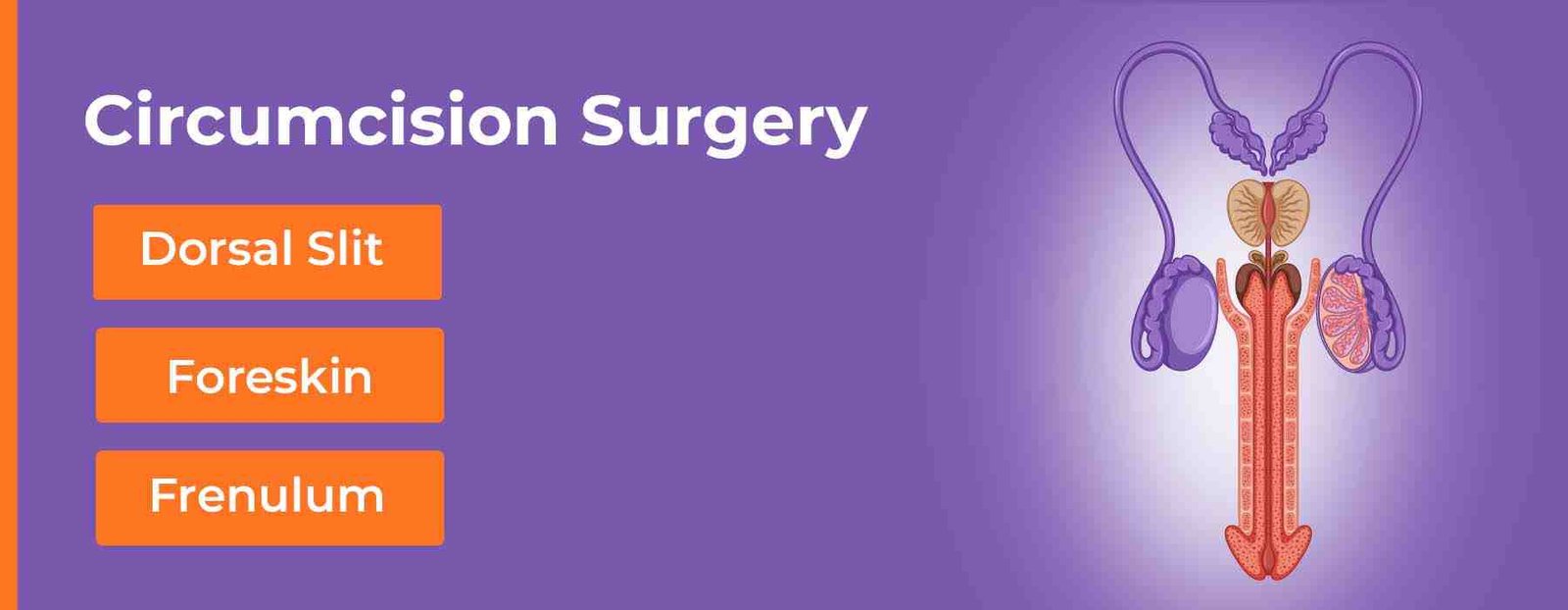Laser Circumcision
Ask the Experts

Circumcision is a surgical operation that involves the elimination of the foreskin, that is the retractable tissue masking the pinnacle of the penis.
The Circumcision procedure is generally completed on male toddlers or boys, although it is able to also be carried out on person men.
- Before the Procedures, the affected person may also get hold of a nearby anesthetic to reduce pain and discomfort.
- The procedure commonly takes about half-hour and is achieved on an outpatient foundation.
- After the procedure, the affected person might also experience some ache, swelling, and bleeding.
- It is crucial to preserve the location clean and dry to prevent infection and sell healing. Pain medicinal drug can be prescribed to manipulate any soreness.

- Phimosis - Unable to Retract Foreskin
- Para Phimosis –Constricting tight ring below the glans of penis
- Religious Circumcision in Muslims infants
- Pain during Sexual Intercourse in Adults
*Laser Circumcision Treatment*: Register Now
Q.1) What is Circumcision (Khatna) or Sunthi ?
Circumcision is the surgical procedure performed by Surgeon to remove the skin covering the tip of the penis.
Q.2) What are the Indications for Circumcision? (when to go for Circumcision)
Circumcision is not always required and is generally taken into consideration an optional procedure, meaning that it's miles a private choice for the individual or their mother and father. However, there are certain scientific and cultural motives which can make circumcision necessary or proper.
Q.3) Why Is Laser Circumcision Performed?
Laser circumcision is a procedure performed on individuals of all ages, including babies and adults. It serves several important purposes:
Hygiene Maintenance: Laser circumcision ensures cleanliness and health in the area where the foreskin has been removed. It makes it easier to maintain and wash the penis effectively.
Prevention of Sexually Transmitted Infections (STIs): Humans often suffer from infections caused by bacteria and viruses transmitted during sexual contact. Laser circumcision reduces the risk of infection transmission through blood, semen, or other bodily fluids.
Management of Urinary Tract Infections (UTIs): Bacterial entry into the urethra can lead to UTIs. Symptoms may include a burning sensation during urination, frequent urination, and blood in the urine.
Addressing Penile Cancer: Uncontrolled growth of cancer cells in the penis can occur. If you notice a large bump or an infected sore, consider a CT scan or penile ultrasound to assess the tumour’s shape and size.
Treatment of Phimosis: Phimosis refers to a condition where the foreskin becomes too tight to retract from the head of the penis. Injury, infection, or inflammation in that area can cause it. Circumcision is an effective solution.
Managing Balanitis: Balanitis involves inflammation of the glans (penis head) due to an overgrowth of microorganisms. Symptoms include swelling, soreness, unpleasant odor, pus, and redness.
Remember that sunthi laser is a medical decision that should be discussed with a healthcare professional based on individual circumstances and needs.
Q.4) What are the Benefits of getting Circumcision done?
1) Reduced risk of repeated Urinary Tract Infections
This infection is reported to less likely occur on circumcised men. Uncircumcised men and babies run a higher risk of getting UTI unlike their circumcised counterparts. Thus, it is beneficial and important to undertake a circumcision surgery.
2) Reduced risk of Penis Cancer
Penile cancer is also not a very common type of cancer. However, studies and statistics show that uncircumcised men run a higher risk of getting penile cancer as compared to circumcised men.
3) Reduced risk in getting sexually transmitted diseases
There are pretty a number of sexually transmitted sicknesses. Nonetheless, sexually transmitted sicknesses are regularly times fatal or can also cause extreme complications if they go unchecked. One of the most deadly sexually transmitted ailment is the HIV virus. Studies display that circumcision reduces the probabilities of a person contracting HIV virus and different sexually transmitted diseases by way of as much as sixty percent. This is a massive margin and it is able to be the difference between life and death.
4) Reduces risk of your wife to develop cervical cancer
Cervical cancer is the leading type of cancer that affects women. Cervical cancer is caused by a number of reasons and research has also shown that women who have uncircumcised partners run a higher risk of getting this type of cancer.
Q.5) What are different methods for Circumcision?
Open Methods & Clamp Methods.

In Open method, the Glans should be exposed at the time of cutting the prepucial skin (foreskin) which is the safest method of all.
Sleeve technique and Dorsal Slit technique are ideal and preferred open methods.
There are many devices available in market which are based on clamp methods resulting in necrosis of the foreskin like Prepex rings, Unicerc device, Stapler device, Plastibell rings etc. Indian Association of Paediatric Surgery does not recommend clamp methods for circumcision because glans is not visible completely during the circumcision and there is high risk of injuring the glans causing its necrosis.
Q.6) Which Anaesthesia is safe for Circumcision in children?
- Local Anesthesia for infants less than 3 months age,
- Sedation/GA for infants 3 – 12 months age,
- General anesthesia for 12 months of age and above.
Q.7) Which tests are required for Circumcision procedure in children?
Surgical Profile – CBC, BT/CT, LFT (optional)
-
Plastibell technique: This involves the use of a plastic ring to cut off the blood supply to the foreskin, which causes it to fall off after a few days.
-
Gomco clamp technique: This involves using a clamp to crush the foreskin before removing it.
-
Mogen clamp technique: This involves using a clamp to hold the foreskin in place while a scalpel is used to remove it.
Q. 8) How much time it takes for healing of the wound?
7 – 10 days
Q.9) What are Contraindications for Circumcision (when circumcision should not be carried out unless evaluated properly)?
Meatal stenosis – pinhole opening of urethral opening by birth,
Hypospadias – Urethral opening other than its normal site.
Q.10) What Precautions should be taken to plan for Circumcision in infants?
Wait for 3 weeks, if baby is found to have jaundice,
Wait for 3 months in Pre Term & Low Birth Weight babies (less than 2.5kgs)
Q.11) What are the known complications of Circumcision ?
Bleeding from cut skin, Infection of the wound, Haematoma, Necrosis of the glans penis, Urethrocutaneous fistula, Trauma to the glans etc.
We have team of experienced anaesthetist, general surgeons & lady surgeons for this service. We perform safe circumcision for both children and adults.
*Book Your Appointment Now: Register Now
Our Laser Circumcision Specialist Doctors
Laser Circumcision FAQ's
Like any surgery, circumcision is painful up to some extent. But pain can be reduced by anesthetic and other pain medication.These can reduce pain in the procedure and afterward.
Plastibell method works best when a child is one to three months old. This age is best for both mother and child for circumcision.
Conventional ZSR circumcision (khatna) method price range is Rs.23000 to Rs.29000.
Adult circumcision is a simple procedure, It has its own risk too. The most common risks include: Bleeding. You will bleed for a few hours to a few days.
For infants over two months old circumcision is riskier. For older boys and mens Circumcisions are done in hospital by doctor. During religious ceremony professional is hired for circumcision
Circumcisions for adults are less common. uncircumcised adults can decide for themselves whether they need circumcision or not. Some may require circumcision for various health reasons
There will be some changes in size and infections may reduce. They choose this circumcision because of religious reasons
Doctors say after a first circumcision if there is foreskin, Best to do the circumcision at an early age. Boys do not grow foreskin even after aging.
Circumcision's major 3 methods are the Gomco clamp, the Plastibell device , and the Mogen clamp. Cutting foreskin is the same in all methods and block circulation to treat.
Doctors suggest < 1 year old boys are good for circumcision, at this age anesthesia complication is less. At 24 years old there is a need for hospitalization and chances of infection risk is high so doctors don’t recommend it at this age.
సాంకేతికమైన సున్తీ (ఖత్నా) పద్ధతి ధర రూ.23000 నుండి రూ.29000 ఉంటుంది
Ask the Experts
Working Time
- Mon-Sat 09:00 - 19:00
Contact Info
-
Phone: +91 8121 200 400
+91 8121 800 400



